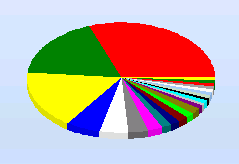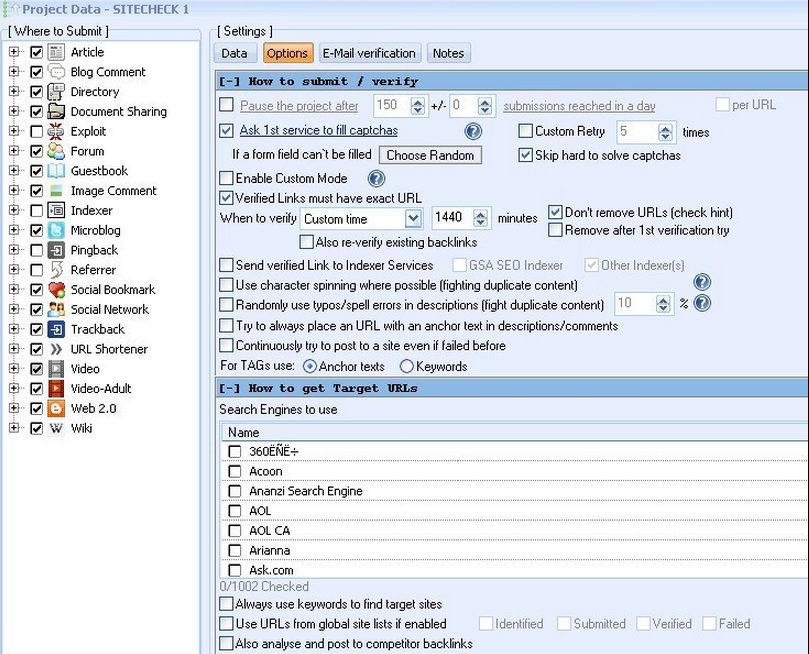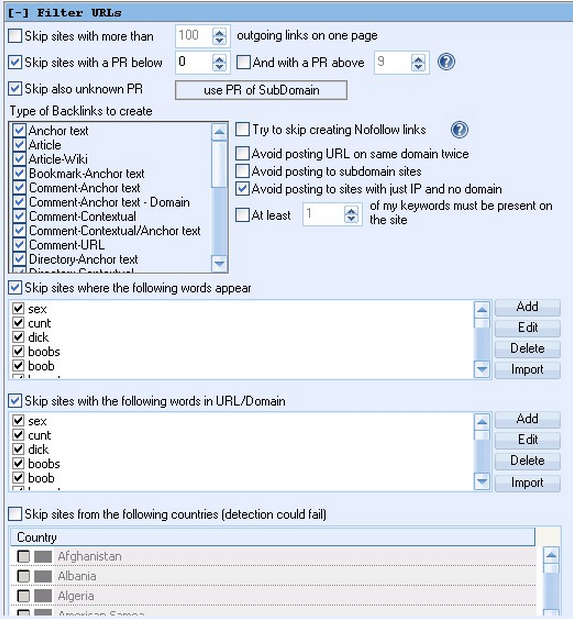 If you have read my GSA SER Review, then you might have been wondering how you can create massive lists to run through GSA to get thousands of links per minute. In this tutorial I am going to show you how you can take an original seed list to expand it into thousands of sites.
If you have read my GSA SER Review, then you might have been wondering how you can create massive lists to run through GSA to get thousands of links per minute. In this tutorial I am going to show you how you can take an original seed list to expand it into thousands of sites.
This will allow you get a ton of verified links without having to scrape for them yourself (which can be slow) and get rid of buying any lists.
What You Will Learn
- Getting a seed list
- Extracting the internal links from the seed list
- Extracting external links
- Sorting your list
Resources Needed
The Main Idea
If you are using GSA SER to post to different blogs, then I am assuming that other users of the software are probably posting to these sites as well. Some GSA users have absolutely massive campaigns for their tiered projects and are blasting hundreds of thousands of links.
What we are going to do is scrape all the internal links of the blogs that you are posting to. This will give you a big list of different posts that have been destroyed by GSA SER.
We will then extract all the external links from the blog post list we have gotten, giving us a list of targets for GSA that other people are using.
 Getting Your Seed List
Getting Your Seed List
The first thing you are going to need to do is find a list. If this is your first time then go to the verified folder of GSA SER and grab all the URLs from all the blog comments you have made. It does not really matter if you have a little list, you will see that even a small list can be expanded to thousands of URLs.
After the first time you do this, you can then just use verified comments from the last project that you successfully used this technique with. If you want a complete site list, then you can grab my starter list below. This is not just blog comments though, it is all platforms.
When you finally have the list, import that list to Scrapebox, trim to the root, get rid of duplicate URLs, and then save the list as “seed list” and move on to the next step.
Extracting the Internal Links
Open up the plugin in Scrapebox called “Link Extractor” and load the seed list you just created into it. Set the mode for the plugin to internal and use as many connections as possible. Start it up and let it run.
Once the process is complete, import the list you just ran though to Scapebox and close the Link Extractor plugin.
Take a look through the list and check out if there are any categories, comment (#comment), tag links or anything like that. You can then use the “Remove URLs containing” option to get rid of these types of links.
You are looking for just a list that is made up of blog posts. This would be ideal. Save the list as “internal links” and go on to the next step.
Optional: Set a project in GSA just to feed in these lists. This will filter out the trash from the blog posts you are looking for. This also can be a great way to build an auto accept list.
Extracting the External Links
I should note that in this step, your original list you use for this is going to be expanded to hundreds of thousands or millions of URLs. This means that you should probably split up your internal links list into smaller files of no more than 10k links per list. this step will usually create 200 times more URLs than you start with and Scrapebox does not seem to link lists more than 1 million URLs as much as I wish it did.
Tip: Use the “Dup Remover” plugin within Scrapebox to split the files.
Okay, so now that you have the internal links list split into smaller files, open up the link extractor plugin and lets get going.
Load in the internal links file, set your mode to “external” and click start.
This may take a while, so enjoy a break while the software does its job. When it is done, transfer the list to ScrapeBox and dedupolicate it again if you need to.
Save the list as something such as: “Needs Sorted”.
Do this over again until all your smaller link lists from your internal links lists are done.
Sort Your List
You should have some pretty big lists on your hands. They need to be sorted! Good news for you, GSA SER can do this!
You will want to setup a new project in GSA SER just like this one. Copy the settings of this picture!


** With these settings, all unindexed sites will be filtered out. If you want to get as many links as possible and do not care about the PR of the pages, then untick the box for PR filters and it will make your project faster and skip the PR check step.
** Also untick all the search engines and the site lists. What you want is this project to only post to the target URL list that you have just imported.
Be sure that you are using one of the main captcha solving software. If you do not use a software you are going to be paying a LOT of money, so pick up one of these two softwares: GSA Captcha Solver or Captcha Sniper.
Next, get some spun content that is relevant to your niche. I prefer to use Kontent Machine.
Once you have everything set up, import your “Needs sorted” list as the target URLs for the project.
BAM! The project will then go through the list and you will see all the successful and verified links!
Tip: Make sure to save the identified, verified and Submitted sites in GSA SER!
You can now repeat the process on the already massive list you just ran through GSA SER to create and even BIGGER list!
Quick Recap
- Grab a list of blog comments that have been verified on GSA
- Extract all the internal links
- Extract all the external links (from your internal links list)
- Import the list to a GSA project and let it sort it out for you
- Rinse and repeat with the verified links you just made!
Enjoy building your free list of sites that you can use yourself or sell to others. Go get those rankings!




Hi Neil, thanks for taking the time to put this together. I have tried a few methods to scrape site lists for GSA but this guide is yielding some massive lists! Once its done I’ll how many verifieds I can get.
Cheers
Nick
Are you the same guy that posted this on BHW?
No, but we are good friends =)
That’s actually a good guide :). Me too wrote a complete newbie guide to GSA SER and this is something that deserves a OBL from me 🙂
Awesome write up! I have been meaning to write up a set up tutorial but have not gotten around to it. You did a great job, keep it up XD
Hi, this is a very informative post.
I followed your process and was able to harvest about 6 million targets. That is the biggest harvest I have been able to achieve since I started using scrapebox for GSA.
Unfortunately got just about 20K GSA verified from the 6 million.Do you have the same experience? Just want to be sure I am not doing something wrong. Thanks.
I am glad you have had some success from this! In my experience, it is about the same. Make sure all your proxies are working and you have all platforms checked in GSA. Keep on harvesting!
Here are two questions:
1. Don’t the seed list have to be unique towards my keyword? Therefore, I would have to first scrape my own Seed List even before I pop them into Link Extractor?
2. What do you mean, “Set a project in GSA just to feed in these lists.”?
3. What if I didn’t dupe my list? It’s a 25mb text file, but can I run this enormous link through SB install of breaking it apart and running each of the smaller files?
4. When repeating the whole process again, you mean to use the newly generated extraction list?
This technique I have mostly used for mass spam so my seed list was just a list of verified URLs for a previous spam campaign. If you want it to be geared towards your niche, then yes, you would need to scrape your own seed list of links that are relevant to your site before you put them into the link extractor.
What I meant by set up a project in GSA to feed in the lists is to create a project in GSA and then run the list through it. When GSA runs, it will not be able to post to any link that is a category page or a tag page so it will essentially get rid of those links for you when GSA has verified all the URLs.
For your third question, you do not need to dupe the list or split it apart. It just makes everything a lot easier to work with and to create bigger lists. Test it out yourself and see what is working best for you. When repeating it again, you are correct to use the newly generated extraction list to keep building much bigger lists. Cheers!
Great guide, I have been doing it a similar way except I use scrapebox’s automator plugin to add a few steps/cut down on time a bit.
So with this method, you are essentially NOT using GSA’s search functionality but instead you are exclusively using Sceapebox’s scraping functionality to create your lists?
That is correct =)
I like you article layout, everything is sorted out 🙂 Easy to follow and read.
I have only 1 question regarding “Sort Your List with GSA” by doing this do you mean that we need to run a campaign before we actually get AA list or Approved list for future campaign?
Oh actually one more question. You must know how serlists(dot)com or other people who sale similar list.
What are there method to scrape links?
Thank You for your article…
By running the list through GSA, only the verified links will be your list so essentially GSA does the work of sorting out the bad links for you. As for serlists, I have never used them but I would assume that they are using something like gscraper running 24/7 on a VPS.
So this will just build list for the “blog comments” right ? Can’t we build site list for other platforms as well ? Like article directories, wikis etc ???
Not necessarily, you are extracting links from blog comments to get the lists of other people, and they may have done much more than just blog comments and GSA would be able to sort that out. Give it a try and see what all kinds of links you can get.
THANKS FOR THIS GREAT POST
I have a question, the last list of external links that gives me the Scrapebox also must leave in domain root and remove duplicate urls before uploading to gsa?
That is correct I think. (I hope I understood your question correctly!)
Thanks Neil!!
You did a good job writting this guide.
Thank you!
Hey man I’m getting errors on the last part. I get these URLs that the “Data” field won’t accept. I tried removing all the #comments, tags, and categories but there are still random URLs that the data field won’t accept. I might have missed a step here can you tell me what it probably is?
Did you run them through a dummy test project to filter them out?
Commenting again so I can be notified of any follow up email. Cheers.
GSA is not submitting comments to the target urls. getting messages like “no engine matches” , “download failed”
Have you checked the list you are using to make sure it is new?